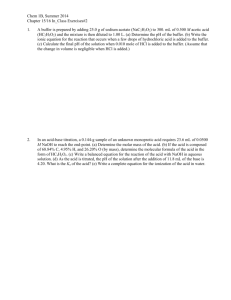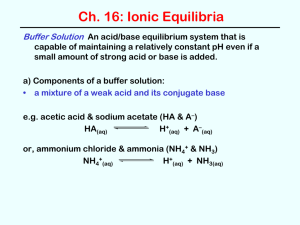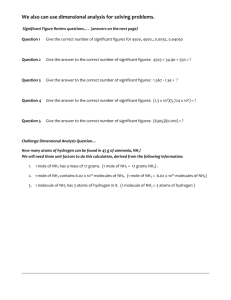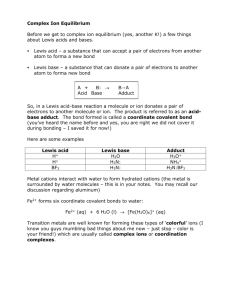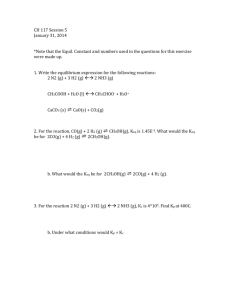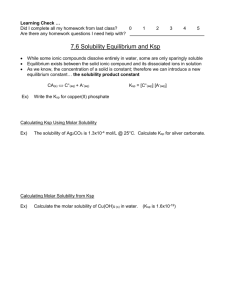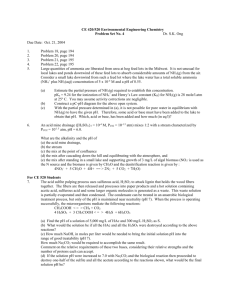Chapt16
advertisement
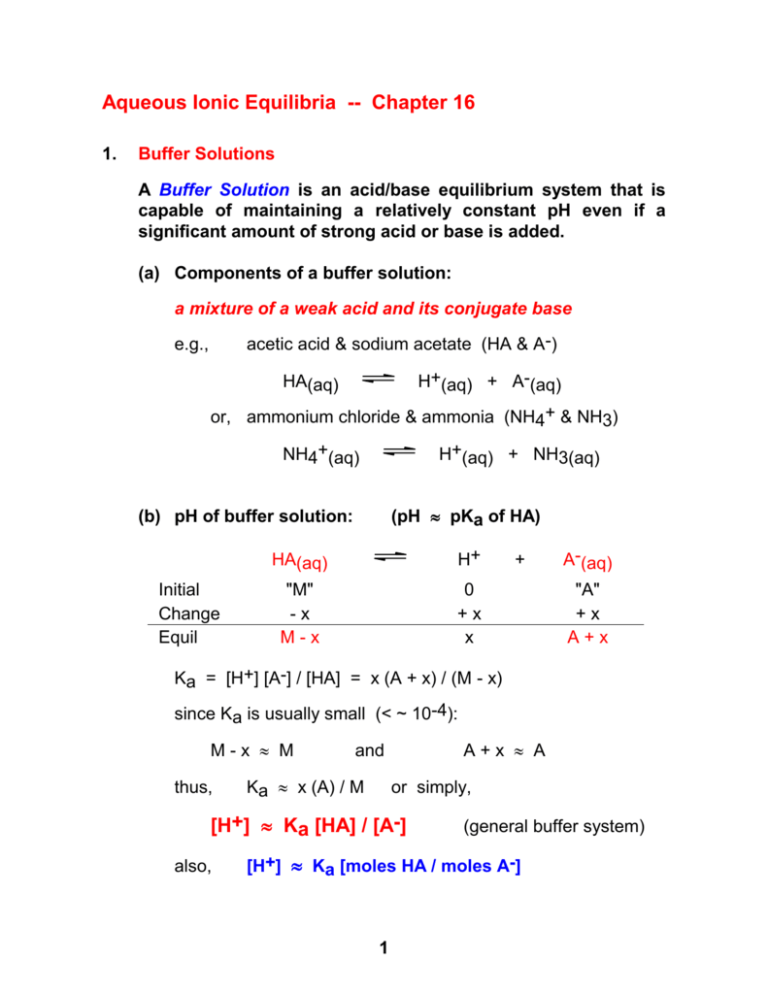
Aqueous Ionic Equilibria -- Chapter 16 1. Buffer Solutions A Buffer Solution is an acid/base equilibrium system that is capable of maintaining a relatively constant pH even if a significant amount of strong acid or base is added. (a) Components of a buffer solution: a mixture of a weak acid and its conjugate base acetic acid & sodium acetate (HA & A-) e.g., H+(aq) + A-(aq) HA(aq) or, ammonium chloride & ammonia (NH4+ & NH3) NH4+(aq) H+(aq) + NH3(aq) (pH pKa of HA) (b) pH of buffer solution: Initial Change Equil H+ HA(aq) "M" -x M-x + 0 +x x A-(aq) "A" +x A+x Ka = [H+] [A-] / [HA] = x (A + x) / (M - x) since Ka is usually small (< ~ 10-4): M-x M thus, A+x A and Ka x (A) / M or simply, [H+] Ka [HA] / [A-] also, (general buffer system) [H+] Ka [moles HA / moles A-] 1 (c) Buffering action (Le Châtelier's Principle) the major equilibrium in a buffer system: HA(aq) H+(aq) + A-(aq) 1. What if some acid (H+) is added? Since H+ is a product of above equilibrium, the reaction will shift in reverse, so that: [HA] will increase and [A-] will decrease But, as long as some A- remains, the system is still a mixture of HA and A-. Therefore, the general equation, [H+] Ka [HA] / [A-] still applies. Thus, [H+] is still Ka 2. What if some base (OH-) is added instead? The added base (OH-) will neutralize some of the acid HA and produce more of the conjugate base, A-. HA + OH- H2O + A[HA] will decrease and [A-] will increase But, as long as some HA remains, the system is still a mixture of HA and A-, and still a buffer solution. Problems 1. (a) The pKa of HF is 3.17. Calculate the pH of a 1.00-L solution that is 1.00 M HF and 1.50 M NaF. (b) What is the pH of this solution after addition of 50.0 mL of 10.0 M HCl? 2. What mass of solid NaCN must be added to 500 mL of 0.50 M HCN to prepare a buffer solution with a pH of 9.50? pKa for HCN is 9.21. 2 2. Acid - Base Titrations (Review general acid-base titration concepts and terms in Chapter 4.8.) Titration of a Weak acid by a Strong Base e.g., 25.0 mL of 0.200 M HA (acetic acid) is titrated with 0.200 M NaOH. Determine pH in each of four regions: (a) at the start -- before any NaOH is added just a simple weak acid: pH = 2.72 (b) before the equivalence point the acid is partially neutralized by the added OHHA + OH- H2O + Asince both HA and A- are now present, the mixture is a buffer solution ! and [H+] Ka (mole HA left) / (mole A- produced) e.g., after addition of 10.0 mL of NaOH, pH = 4.57 (c) at the equivalence point the acid (HA) is completely neutralized, and only the anion A- is present the solution is now the salt of a weak acid ! total volume is now 50.0 mL, so [A-] = 0.10 M and pH = 8.88 (d) after the equivalence point all acid (HA) is gone and excess OH- is present the pH is determined by how much OH- is left after all the acid has been neutralized e.g., after 40.0 mL of NaOH added: pH = 12.66 3 SUMMARY of Acid - Base Equilibrium Concepts (Chapters 15 and 16) 1. pH scale and the autoionization of water (Kw) 2. Strong acids and bases 3. Weak acids and bases (Ka or Kb) 4. Salts of weak acids and salts of weak bases (conjugate pairs: Kw = KaKb) 5. Buffer solutions (Ka) (mixture of weak acid and its conjugate base) 6. Polyprotic acids (Ka1 and Ka2 etc.) 7. Acid-Base Titrations (especially weak acid by strong base) Do not use the Henderson-Hasselbalch Equation on the Exams ! ! ! pH = pKa + log [acid] [base] 4 = No Points! 3. Solubility Equilibria (a) "Insoluble" salts are actually sparingly soluble equilibrium: e.g., solid salt ions in solution In a saturated solution of Ag2CO3, the following equilibrium is occurring. 2 Ag+(aq) + CO32-(aq) Ag2CO3(s) Solubility Product Constant = Ksp Ksp = [Ag+]2 [CO32-] = 8.1 x 10-12 Given a Ksp value, determine the "molar solubility" let x = molar solubility ! = moles Ag2CO3 dissolved / liter [CO32-] = x and [Ag+] = 2x Ksp = 8.1 x 10-12 = [Ag+]2 [CO32-] = (2x)2 (x) x = 1.3 x 10-4 M Ksp = 4x3 (b) Common ion effect: Sparingly soluble salts are even less soluble when a "common" ion is present. Le Châtelier's Principle applies here: salt cation + anion If an excess of one of the ions is present, the equilibrium will shift in reverse and less salt will dissolve! 5 Problem -- Molar solubility of Ag2CO3 in 0.10 M Na2CO3 ? let x = molar solubility of Ag2CO3 [Ag+] = 2x and, [CO32-] = 0.10 + x Ksp = 8.1 x 10-12 = [Ag+]2 [CO32-] = (2x)2 (0.10 + x) but since Ag2CO3 is not very soluble, assume x << 0.1 Ksp (2x)2 (0.10) 8.1 x 10-12 x 4.5 x 10-6 M (c) When will a precipitate form? The solution must be saturated for a ppt to form. Thus, the initial ion concentrations must be greater than the equilibrium values. e.g., 2 Ag+(aq) + CO32-(aq) Ag2CO3(s) If initial concentrations of the ions are given, calculate the ion product: Q = [Ag+]2 [CO32-] using the initial conc values If Q > Ksp then a precipitate will form! (d) "Insoluble" salts of weak acids are more soluble in acidic solutions e.g., Ag2S(s) 2 Ag+(aq) + S2-(aq) if the solution is acidic, some S2- will be converted to HS- and H2S, thus causing more Ag2S to dissolve 6 The process can be viewed as a combination of multiple equilibria, occurring simultaneously: Ag2S(s) 2 Ag+(aq) + S2-(aq) H+(aq) + S2-(aq) HS-(aq) H+(aq) + HS-(aq) H2S(aq) Net: Ag2S(s) + 2 H+(aq) 2 Ag+(aq) + H2S(aq) Omit Section 16.7 -- Qualitative Analysis 4. Complex Ion Equilibria (increases solubility) Metal ions form complex ions with Lewis bases, such as: Cu2+(aq) + 4 NH3(aq) Cu(NH3)42+(aq) This type of reaction is generally very favorable so… K is very large ! The equilibrium constant is called a Formation Constant Kf = [Cu(NH3)42+] / [Cu2+] [NH3]4 = 1.1 x 1013 (Large !) If a complex ion can form, then an "insoluble" salt will be much more soluble (Le Châtelier Principle again !). another example: Ag+(aq) + 2 NH3(aq) Ag(NH3)2+(aq) Formation Constant: Kf = [Ag(NH3)2+] / [Ag+] [NH3]2 = 1.6 x 107 7 Problem Given the above formation constant for Ag(NH3)2+ and the Ksp value for AgBr of 5.0 x 10-13, calculate the molar solubility of AgBr in (a) water, and (b) 0.10 M NH3. (a) in water: Ag+(aq) + Br-(aq) AgBr(s) Ksp = [Ag+] [Br-] = x2 = 5.0 x 10-13 x = molar solubility = 7.1 x 10-7 (b) in NH3 solution, two equilibria must be considered: Ksp: Kf: Knet: AgBr(s) Ag+(aq) + Br-(aq) Ag+(aq) + 2 NH3(aq) Ag(NH3)2+(aq) Ag(NH3)2+(aq) + Br-(aq) AgBr(s) + 2 NH3(aq) Knet = [Ag(NH3)2+] [Br-] / [NH3]2 = Ksp Kf = (5.0 x 10-13) (1.6 x 107) = 8.0 x 10-6 let x = molar solubility of AgBr [Ag(NH3)2+] = [Br-] = x [NH3] = 0.10 - 2x (2 : 1 stoichiometry for NH3) Knet = x2 / (0.10 - 2x)2 = 8.0 x 10-6 since Knet is small in this case, assume 2x << 0.10 x2 / (0.10)2 8.0 x 10-6 x 2.8 x 10-4 AgBr is about 1,000 times more soluble in NH3 solution than in water alone. 8
